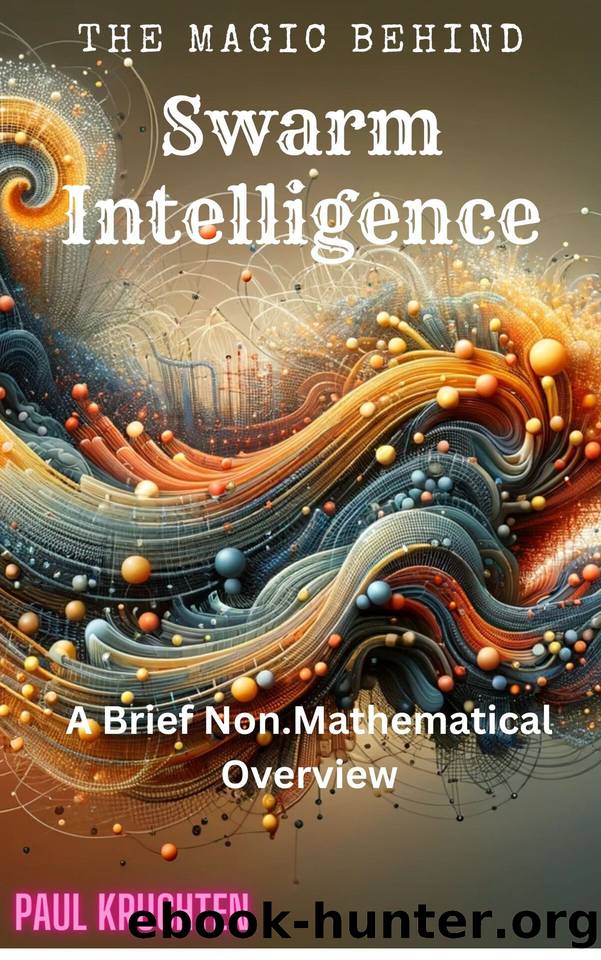The Magic Behind Swarm Intelligence: A Brief Non-Mathematical Overview by kruchten paul

Author:kruchten, paul
Language: eng
Format: epub
Published: 2024-01-06T00:00:00+00:00
6.1. **System Performance with Varying Swarm Sizes**:
This topic focuses on how the performance of a swarm intelligence system changes as the number of agents in the swarm increases or decreases. It includes examining the thresholds beyond which adding or removing agents impacts efficiency, and understanding how to optimize swarm size for specific tasks or environments.
In the multifaceted domain of swarm intelligence, the impact of varying swarm sizes on system performance is a topic of profound significance, intricately tied to the principle of scalability. This relationship between swarm size and performance is not linear nor straightforward; it is characterized by a nuanced interplay of emergent behaviors, resource constraints, and task complexities. In this context, understanding how system performance scales with the size of the swarm is pivotal, as it underpins the efficiency, adaptability, and overall efficacy of swarm-based systems.
As swarm sizes increase, one of the most striking observations is the emergence of increasingly complex and sophisticated collective behaviors. Larger swarms benefit from a denser network of interactions among agents, leading to a richer pool of shared information and more robust decision-making processes. This enhanced communication and interaction facilitate more nuanced collective strategies, allowing the swarm to undertake complex tasks that would be unfeasible for smaller groups. In tasks such as area exploration, search and rescue, or distributed sensing, larger swarms can cover more ground and process information more comprehensively, leading to a marked improvement in performance.
However, the relationship between swarm size and system performance is not without its challenges. One of the critical considerations is the issue of coordination and control overhead. As the swarm grows, coordinating the actions of an increasing number of agents can become more complex. The risk of interference, collision, or communication bottlenecks can rise, potentially leading to diminishing returns in efficiency. Effective swarm design must, therefore, incorporate mechanisms to mitigate these challenges, such as decentralized control structures, robust communication protocols, and algorithms that prevent overcrowding and ensure efficient task distribution.
Another intriguing aspect of scalability in swarm intelligence is the concept of task scalability. Certain tasks may naturally lend themselves to larger swarms, such as distributed data collection or large-scale construction projects. In contrast, tasks that require precision or are confined to limited spaces may see optimal performance with smaller swarms. The key lies in aligning the swarm size with the nature and requirements of the task, ensuring that the number of agents is neither excessively large nor insufficiently small.
Moreover, the scalability of system performance in swarm intelligence is closely linked to the adaptability and learning capabilities of the swarm. Larger swarms can exhibit enhanced learning and adaptation, as they benefit from a broader range of experiences and interactions among agents. This collective learning can lead to an iterative improvement in performance over time, as the swarm refines its strategies and behaviors in response to environmental feedback and task demands.
In essence, the relationship between swarm size and system performance in the context of scalability in swarm intelligence is a dynamic and multifaceted one. It highlights the delicate
Download
This site does not store any files on its server. We only index and link to content provided by other sites. Please contact the content providers to delete copyright contents if any and email us, we'll remove relevant links or contents immediately.
Whiskies Galore by Ian Buxton(41879)
Introduction to Aircraft Design (Cambridge Aerospace Series) by John P. Fielding(33064)
Rewire Your Anxious Brain by Catherine M. Pittman(18553)
Craft Beer for the Homebrewer by Michael Agnew(18140)
Cat's cradle by Kurt Vonnegut(15184)
Sapiens: A Brief History of Humankind by Yuval Noah Harari(14252)
Leonardo da Vinci by Walter Isaacson(13182)
The Tidewater Tales by John Barth(12608)
Thinking, Fast and Slow by Kahneman Daniel(12074)
Underground: A Human History of the Worlds Beneath Our Feet by Will Hunt(12024)
The Radium Girls by Kate Moore(11921)
The Art of Thinking Clearly by Rolf Dobelli(10221)
A Journey Through Charms and Defence Against the Dark Arts (Harry Potter: A Journey Throughâ¦) by Pottermore Publishing(9232)
Mindhunter: Inside the FBI's Elite Serial Crime Unit by John E. Douglas & Mark Olshaker(9201)
Tools of Titans by Timothy Ferriss(8218)
Wonder by R. J. Palacio(8010)
Turbulence by E. J. Noyes(7936)
Change Your Questions, Change Your Life by Marilee Adams(7635)
Nudge - Improving Decisions about Health, Wealth, and Happiness by Thaler Sunstein(7615)
